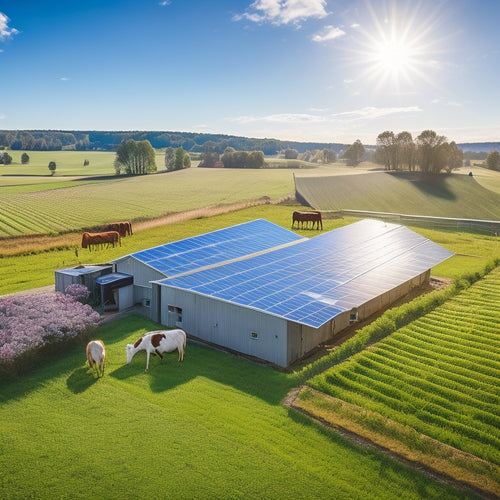
Residential Solar Panel Mounting Options Explained
Share
When choosing a residential solar panel mounting system, you'll encounter various options catering to different roof types, sizes, and orientations. Roof-mounted systems maximize energy production on rooftops, while ground-mounted options offer flexibility in placement and size. Solar panel tracking systems, available in single and dual axis configurations, optimize energy production by adjusting panel angles. Adjustable tilt and flush mount installations provide sleek designs, and rail mounting systems secure panels with high-strength materials. Ballasted mounting uses weights to secure panels without penetrating the roof. Each option has its benefits and challenges, and understanding their intricacies will help you make an informed decision to meet your energy needs.
Overview
- Roof-mounted solar panels are ideal for maximizing energy on rooftops, but aesthetics and roof type affect installation requirements.
- Ground-mounted solar panels offer flexibility in placement and size, benefiting homes with limited roof space or obstructions.
- Solar panel tracking systems, including single and dual axis, adjust panel angles to optimize energy production and increase efficiency.
- Adjustable solar panel tilt allows fine-tuning of panel angles to maximize solar efficiency year-round, with seasonal adjustments for peak performance.
- Various mounting options, including flush mount, rail mounting, and ballasted mounting, cater to different roof types and installation constraints.
Roof-Mounted Solar Panel Systems
Your rooftop is an ideal location for utilizing solar energy, and roof-mounted solar panel systems are a popular choice for homeowners.
When considering a roof-mounted system, think about solar panel aesthetics, guaranteeing the installation complements your home's design.
Installation considerations include evaluating your roof type, as asphalt shingles, metal, and clay tiles have different requirements. Be aware of shading effects from trees, buildings, or other obstructions.
It's vital to select compatible systems for metal roofs, using roof integration systems to secure panels without roof penetration, minimizing the risk of leaks and structural damage.
Mounting materials, such as aluminum or stainless steel, must withstand wind resistance and harsh weather conditions.
Ascertain maintenance access is easy, as regular cleaning and inspections are significant.
Ground-Mounted Solar Panel Options
While roof-mounted systems are a popular choice, ground-mounted solar panel options offer a versatile alternative for homeowners who want to capture solar energy without compromising their roof's integrity.
You can install ground-mounted systems almost anywhere on your property, providing more flexibility regarding placement and size. This is particularly beneficial for those with limited roof space or obstacles like skylights or vents.
Ideal site selection is vital, considering factors like shading and wind direction, to guarantee maximum energy production.
Ground-mounted systems can also be integrated into permaculture designs, allowing you to utilize solar energy while maintaining a sustainable and eco-friendly environment. Additionally, they promote soil stability by minimizing soil disturbance and erosion.
Solar Panel Tracking Systems
You'll want to take into account solar panel tracking systems, which optimize energy production by adjusting the panel's angle to match the sun's movement.
These systems come in two primary configurations: single axis tracking, which adjusts the panel's angle in one direction, and dual axis tracking, which adjusts in two directions for even greater precision.
By choosing the right tracking system, you can greatly enhance your solar panel's energy output.
Adjustable mounting options allow for precise angle adjustments, enabling seasonal adjustments to improve energy output by matching sun angles, and tilt flexibility to capture more energy in winter and maximize summer production.
Single Axis Tracking
A solar panel tracking system's primary function is to optimize energy production by adjusting the panel's angle to match the sun's movement.
With single axis tracking, you'll get a system that adjusts the panel's angle on one axis, typically from east to west. This allows the panel to follow the sun's daily movement, increasing solar efficiency by up to 25%.
While installation costs are higher than fixed-tilt systems, single axis tracking can provide a faster return on investment due to increased energy production.
You'll need to evaluate factors like roof size, local building codes, and system compatibility when deciding if single axis tracking is right for you.
Dual Axis Tracking
How does a solar panel tracking system take energy production to the next level?
Dual axis tracking systems enhance energy efficiency by adjusting the panel's orientation to match the sun's movement across both the x and y axes. This technology advancement elevates energy production by up to 45% compared to fixed-tilt systems.
While installation challenges and higher upfront costs may deter some, the long-term cost benefits and increased energy output make dual axis tracking a viable option. However, site selection and orientation impact must be carefully considered to maximize energy production.
In addition, weather effects, such as high winds, may require additional maintenance requirements. Despite these considerations, dual axis tracking systems offer unparalleled energy efficiency and freedom from traditional energy sources.
Adjustable Solar Panel Tilt
Optimizing solar panel performance requires careful consideration of panel tilt, as it greatly impacts energy output.
Adjustable solar panel tilt systems allow you to fine-tune your panel's angle to maximize solar efficiency throughout the year. By making seasonal adjustments, you can guarantee your system operates at peak performance during changing sunlight patterns.
During winter, you can tilt your panels at a steeper angle to capture more sunlight, and in summer, you can adjust them to a shallower angle to minimize overheating.
This flexibility enables you to leverage the most energy possible, giving you more freedom from the grid. With an adjustable tilt system, you can optimize your energy output and enjoy the benefits of renewable energy.
Flush Mount Solar Panel Installation
During the solar panel installation process, you'll need to decide on a mounting method that suits your roof type and personal preferences.
Flush mount solar panel installation is a popular choice, offering a sleek, low-profile design that blends seamlessly with your roof. This method involves attaching the solar panels directly to your roof, eliminating the need for rails or clamps.
One of the significant cost benefits of flush mounting is reduced material costs, as you won't need to purchase additional hardware.
However, installation challenges may arise, particularly on roofs with complex angles or multiple skylights. Confirm you work with an experienced installer to maneuver these challenges and maximize your energy output.
Solar Panel Rail Mounting Systems
Solar Panel Rail Mounting Systems offer a versatile and widely used method for securing solar panels to your roof.
You'll appreciate the durability of these systems, which use high-strength materials like anodized aluminum to withstand harsh weather conditions.
The installation process typically involves attaching rails to your roof, then clipping the solar panels onto the rails. This approach allows for flexibility regarding panel orientation and spacing, making it suitable for various roof types.
Aesthetically, rail mounting systems can be designed to blend seamlessly with your roof's design.
While they may be more expensive than other options, they offer superior wind load resistance and require minimal maintenance.
Ballasted Solar Panel Mounting
Installing ballasted solar panel mounts involves placing weights or ballasts on your roof to hold the panels in place, eliminating the need for penetrating fasteners.
This non-invasive approach is ideal for roofs with specific installation constraints or where structural integrity is a concern.
When considering ballasted solar panel mounting, you'll need to determine the required ballasted weight based on factors like roof type, wind load, and panel size.
Installation considerations include ensuring the ballasts are distributed evenly and strategically placed to prevent roof damage or shifting.
Frequently Asked Questions
Can I Mix and Match Different Mounting Options for My Solar Panels?
You can mix and match different mounting options, but guarantee mounting compatibility and consider panel orientation to optimize energy production; however, you'll need to verify compatibility with your solar panel brand and local building codes.
How Do I Ensure My Solar Panels Are Secure in High Winds?
You guarantee your solar panels are secure in high winds by selecting mounting materials with high wind resistance, like anodized aluminum or stainless steel, and following manufacturer guidelines for installation and anchoring.
Are There Any Solar Panel Mounting Options for Metal Roofs?
As you consider solar panels for your metal roof, you'll find it's no coincidence that metal roof advantages include durability and strength, making them ideal for solar installations, which require specialized installation techniques to guarantee a secure and efficient setup.
Can I Install Solar Panels on a Flat Roof With a Rubber Membrane?
You can install solar panels on a flat roof with a rubber membrane, but you'll need to take into account flat roof considerations, ensuring the mounting system is compatible with the rubber membrane to prevent damage and leaks.
Do Solar Panel Mounting Systems Come With a Warranty?
You're wise to wonder if your investment's protected; yes, reputable manufacturers offer warranties on solar panel mounting systems, covering mounting materials and adherence to installation guidelines, giving you peace of mind and financial security.
Ready to Buy
You've weighed your options and now you're ready to capture the sun's energy. Whether you opt for roof-mounted, ground-mounted, or tracking systems, adjustable tilt, flush mount, rail-mounted, or ballasted solutions, each choice offers unique benefits and drawbacks. Consider your roof's size and condition, available land, and local building codes to select the perfect fit. By choosing the right mounting option, you'll maximize your solar panel's energy output, streamline maintenance, and enjoy a stronger return on investment.
Related Posts
-

What Do I Need to Know About Farm Solar Panels
When considering farm solar panels, you need to assess costs, benefits, and technical specifics. Initial investment c...
-

Building an Emergency Backup Solar Power System in 5 Essential Steps
Building an emergency backup solar power system involves five key steps. First, assess your daily energy needs to ide...
-

Smart Grid Technology Implementation Challenges
You'll encounter several challenges when implementing smart grid technology, particularly in cost management, scalabi...


